download report - Sapienza
download report - Sapienza
download report - Sapienza
You also want an ePaper? Increase the reach of your titles
YUMPU automatically turns print PDFs into web optimized ePapers that Google loves.
Scientific Report 2007-2009<br />
Astronomy & Astrophysics<br />
A16. Testing fundamental physics with cosmology<br />
Our research interests are focused on theoretical cosmology,<br />
with a particular emphasis on the study of the<br />
Cosmic Microwave Background (herafter CMB). The<br />
CMB provides indeed an unexcelled probe of the early<br />
universe. Its close approximation to a blackbody spectrum<br />
constrains the thermal history of the universe. Its<br />
isotropy provides a fundamental probe of our standard<br />
theories for the origin of large-scale structure back to the<br />
effective ‘photosphere’ of the universe, when the universe<br />
was only one-thousandth of its present size. The future<br />
of cosmology as a mature and testable science lies in the<br />
realm of observations of CMB anisotropy and its polarization.<br />
Near future experiments as the Planck satellite<br />
(in which we are fully involved) will soon provide<br />
new data that will help in solving some key cosmological<br />
questions taht we list below.<br />
Constraints on Dark Energy - A major goal of<br />
modern cosmology is to investigate the nature of the dark<br />
energy component, responsable for the current accelerated<br />
expansion of the Universe. Despite the fact that<br />
it accounts for about 70% of the total energy density of<br />
the universe, dark energy is largely unclustered and is<br />
typically measured just by its effect on the evolution of<br />
the expansion history (i.e. the Hubble parameter). Since<br />
the cosmic expansion depends on other key parameters<br />
as curvature or matter density, the nature of dark energy<br />
can therefore be revealed only by combination of different<br />
observables and/or observations over a wide redshift<br />
range.<br />
A key parameter for determining the nature of dark<br />
energy is the equation of state. Recently, in collaboration<br />
with Asantha Cooray at the University of California<br />
Irvine and Daniel Holtz of Los Alamos Labs we<br />
performed a complete analysis of current cosmological<br />
datasets. The results, presented in [1], shows that current<br />
data are compatible with an equation of state as<br />
expected from a cosmological constant, showing no deviations<br />
from this simple, yet puzzling, model. In a recent<br />
paper in collaboration with Prof. George Smoot at the<br />
University of Berkeley (Nobel Prize 2006 in Physics) we<br />
studied the possibility of constraining dark energy with<br />
the CMB anisotropies weak lensing [2].<br />
Cosmological Constraints on Neutrino Physics<br />
- Neutrinos play a relevant role in large scale structure<br />
formation and leave key signatures in several cosmological<br />
datasets. More specifically, neutrinos suppress the<br />
growth of fluctuations on scales below the horizon when<br />
they become non relativistic. if neutrinos have masses in<br />
the (sub)eV range would then produce a significant suppression<br />
in the galaxy clustering. It is therefore possible<br />
to derive strong, albeit indirect, constraints on the mass<br />
of the neutrino particle by analyzing cosmological data.<br />
The nice aspect of this investigation is that neutrino<br />
masses in the (sub)eV range of energies can be probed<br />
directly in laboratory. A comparison of the cosmological<br />
constraints with those that will soon obtained from,<br />
for example, single or double beta decay experiments,<br />
could either provide a strong confirmation of the theory<br />
or reveal the presence of new physics.<br />
In [3] we showed that future cosmological data could<br />
reach a sensitivity close to ∼ 0.01eV , probing the neutrino<br />
mass hierarchy.<br />
Cosmological Constraints on Inflation - Inflation<br />
has become the dominant paradigm for understanding<br />
the initial conditions for structure formation and<br />
for CMB anisotropies. In the inflationary picture, primordial<br />
density and gravitational-wave fluctuations are<br />
created from quantum fluctuations, “redshifted” beyond<br />
the horizon during an early period of superluminal expansion<br />
of the universe, then “frozen”. Perturbations at<br />
the surface of last scattering are observable as temperature<br />
anisotropies in the CMB.<br />
In the past years we made use of the most recent CMB<br />
data to discriminate among the various inflationary models.<br />
More recently, we have investigated the ability of future<br />
experiments in constraining single field scenarios in [4].<br />
References<br />
1. P. Serra, et al, Phys.Rev. D, 80, 121302, (2009).<br />
2. E. Calabrese et al, Phys.Rev. D, 80, 103516 (2009).<br />
3. F. De Bernardis, et al., Phys.Rev. D, 80, 123509 (2009).<br />
4. L. Pagano, et al, JCAP, 0804:009, (2008).<br />
Authors<br />
A. Melchiorri, E. Calabrese, F. De Bernardis, M. Martinelli,<br />
L. Pagano<br />
<strong>Sapienza</strong> Università di Roma 163 Dipartimento di Fisica

















